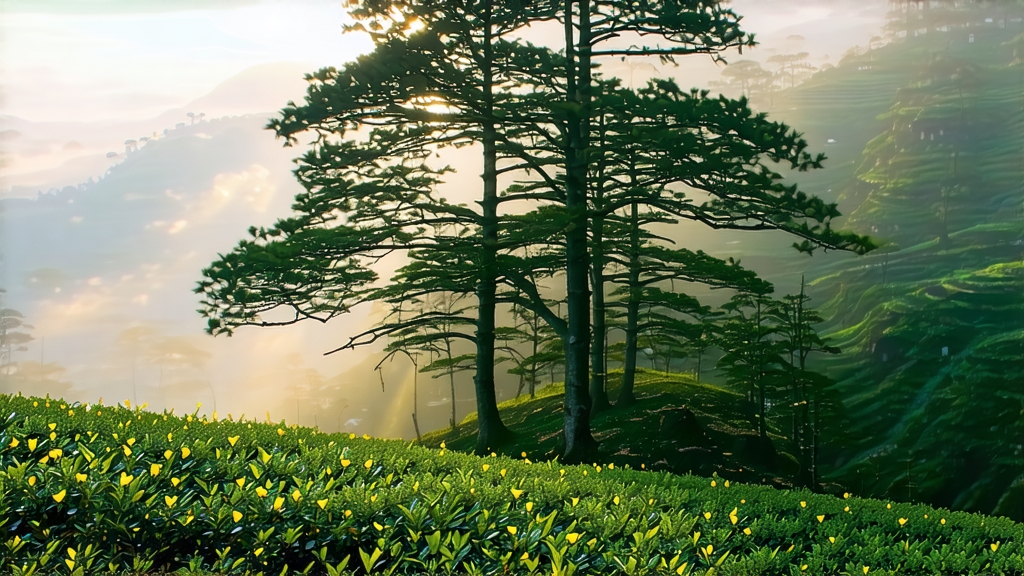
Tucked high on the shoulders of sacred Mengding Mountain in Sichuan Province, Mengding Huangya—literally “Yellow Bud of Mengding”—has been whispering its mellow, chestnut-sweet secrets for more than twelve centuries. Foreign tea lovers often greet the word “yellow tea” with blank stares; even inside China it is the rarest of the six great tea families. Yet within that vanishing category, Mengding Huangya is the most venerable, the first yellow tea ever written into history, and the only one ever listed exclusively for the emperor’s cup. To sip it today is to taste a vanished dynasty’s etiquette, the mountain’s cloud-wrapped biodiversity, and a craft so labor-intensive that fewer than thirty families still remember how to perform it correctly.
History: from imperial altar to near extinction
The mountain’s tea story begins in 53 BCE when the Taoist monk Wu Lizhen planted seven tea bushes on the summit, declaring them “celestial herbs.” By the Tang dynasty (618-907) those bushes—still alive today, crowned as “the seven immortal tea trees”—were yielding buds that traveled the Jiannan Road to Chang’an’s palace. An edict of 724 CE specifically demanded “yellow buds of Mengding” for the spring sacrifice, making it China’s first officially codified tribute tea. Song emperors expanded the quota; Ming emperors sealed the mountain, forbidding commoners even to gaze at the groves. The last imperial order arrived in 1908, after which the mountain’s monks quietly kept the craft alive through war, land reforms, and the Cultural Revolution. When yellow tea markets collapsed in the 1980s, farmers switched to faster-paying green teas; by 2005 fewer than 300 kg of authentic Mengding Huangya were produced in a year. A slow, state-backed revival began in 2008, yet annual output remains below two tonnes—rarer than Da Hong pao mother-tree tea.
Micro-terroir: why the mountain makes yellow possible
Mengding rises to 1,456 m inside a 96 % humidity cloud belt. Morning mist refracts sunlight into a soft, blue-heavy spectrum that lengthens the buds’ amino acid synthesis, doubling the theanine level of valley teas. Night temperatures drop 10 °C, locking in malic and citric acids that later convert into honeyed notes during yellowing. The soil is a 2-m-deep layer of weathered purple sandstone rich in ionic iron; it acts like a natural pH buffer, keeping leaf cell walls elastic long after plucking—an essential condition for the “sealed yellowing” step that follows.
Plucking: one bud, one standard, 72 minutes
The harvest window opens on the first day after Qingming when the mountain’s thermometer holds steady between 12 °C and 16 °C. Only the unopened bud—called “sparrow’s tongue” for its slightly hooked tip—is taken. A master picker can gather 600 g in 72 minutes; 22,000 buds (5 kg fresh) are needed for 1 kg of finished tea. The pluck must reach the workshop within 90 minutes, before dawn dew evaporates, because surface moisture acts as the catalyst for the yellowing enzymes.
Craft: the dance of killing green and coaxing yellow
Step 1: Gentle kill-green
Leaves are tossed into a 140 °C wok for 3–4 minutes with a hand motion named “butterfly flutters over peony.” The goal is not full de-enzyming like in green tea; polyphenol oxidase must be left at 12–15 % activity so it can later generate the golden pigments.
Step 2: Initial rolling
A 5-minute roll on a bamboo tray breaks 30 % of cell walls, releasing sticky sap that will glue the bud hairs together during yellowing.
Step 3: First piling (“men huang”)
The semi-damp buds are wrapped in steamed rice paper, then buried inside a 5-cm-thick layer of fresh wheat straw. The straw exudes thermophilic bacteria that raise the core to 38 °C within 90 minutes. Every 20 minutes the master unwraps, fluffs, and re-wraps, judging by aroma alone when the pile must cool. This repeats six times across 48 hours, transforming chlorophyll into pheophytin and oxidizing catechins into theaflavins, yielding